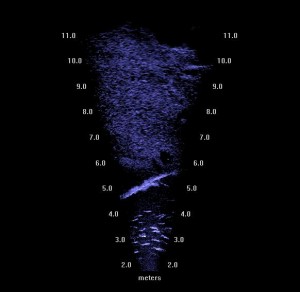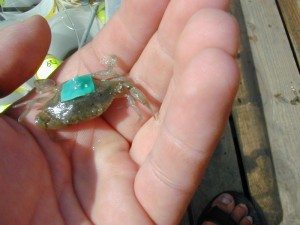By Katie Sinclair
A short DIDSON clip of a cownose ray swimming near the SERC dock
One of the biggest challenges of studying life in the Chesapeake Bay is poor visibility. In the water, you literally can’t see your hand in front of your face. So how do you see what’s going on under the water? Sampling with nets can give us a pretty good picture, but if you want to observe what’s happening at a specific moment you need to use another approach.
The Fish and Invertebrate Ecology Lab is using Dual-frequency Identification Sonar (DIDSON) to see what their eyes can’t. The DIDSON uses sound to sketch a picture of the environment much like a fish-finder or depth-finder on a boat. When sound hits an object in the water or the bottom, it bounces back. The result is video footage that can be downloaded and later analyzed. The resolution of the image is pretty impressive, considering it’s the product of sound waves. Many species can be identified by their distinct shapes and movement patterns, and their sizes can be estimated. DIDSON was first developed for the military to locate enemy swimmers , but is now being used as a handy tool by anyone who needs to see in murky waters.
River Herring
The Fish and Invertebrate Lab started using DIDSON with the goal of better understanding the size of river herring populations in Chesapeake Bay. Funded jointly by the National Fish and Wildlife Foundation and the Smithsonian Institution, the project aims to generate accurate population counts of river herring in the Choptank and Nanticoke Rivers. Once a species that supported a major fishery on the Atlantic coast, river herring (actually two species known as alewife and blueback herring) have declined dramatically over the past 10 years. In order to figure out the best way to conserve and manage these populations, the first step is to figure out how many herring are out there. The murky waters and large run sizes make it nearly impossible to get an accurate visual count. Other methods, such as electrofishing and looking at icthyoplankton (fish eggs and larvae) can potentially work as counting methods, but first it must be established how accurate they really are. By deploying the DIDSON during the spring herring runs, footage of the runs can be recorded and the number of fish counted. DIDSON also allows fish to be recorded for several months straight without requiring someone to be out in the field sampling all day and night.
Predator-Prey Interactions
DIDSON is also being used to help better understand predator and prey interactions in Chesapeake Bay. Long-term tethering experiments going back over 20 years suggest that juvenile blue crabs suffer significant predation from adult blue crabs. Tethering involves fastening a meter of vinyl-coated wire to crabs, which is anchored to the bottom with a metal spike marked with a float. The crabs are free to move and burrow, but cannot go beyond their one-meter radius. Predator identities can sometimes be inferred from crab remains, but that’s not possible when all that’s left is a length of severed string.
Mark Ruiz, an undergraduate at Texas A&M who interned at SERC, and Dr. Matt Ogburn, a SERC postdoctoral fellow, used DIDSON to figure out exactly who is responsible for the juvenile crab deaths. They tethered five crabs a day, leaving them out for 24 hours and then releasing them and tethering 5 more crabs the next day. After the four-day experiment ended, Mark buckled down to sort through 96 hours of DIDSON footage (aided by the internet radio station Pandora). Mark noted and measured any potential blue crab predators that swam through the frame, including fish, cownose rays, eels and, of course, blue crabs. Over four days, five of the 20 juvenile blue crabs were eaten, for a mortality rate of 25 percent. Most importantly, every one of the five eaten crabs was killed by an adult blue crab, even though large predatory fish were often in the area.
A crab (bottom) in pursuit of a tethered crab
Mark recorded the sizes of the blue crabs that approached the tethered juveniles and found that the size distribution matched the general size distribution of the blue crab population. Mark was also able track to the activity of fish and crabs over the course of the day and tide. He found that fish were more likely to be present in the early morning to mid-afternoon, eels present at noon, and rays in the midafternoon, while blue crabs were most often present around high tide. Mark’s work with the DIDSON provided even more evidence that the biggest predators of juvenile blue crabs are adult blue crabs. Comparing mortality of juveniles taken from long term tethering at SERC to population data from the Maryland Department of Natural Resources shows that juvenile mortality is closely related to the population of adults.
With DIDSON technology, the Fish and Invertebrate Lab is able to get a clear view of the world hidden under the murky waters of the Chesapeake. Understanding the population dynamics of river herring and predation of blue crabs will provide valuable insights into conserving and managing this vital ecosystem.



